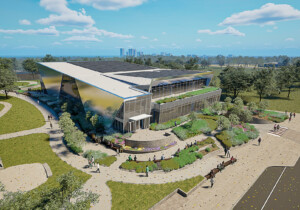Among the Windy City’s most well-known assets are its universities, from DePaul in Lincoln Park and the Loop to the University of Chicago in Hyde Park. Many of these campuses, in turn, are characterized by heavy brick and stone architecture in the Neo-Gothic style. The dominance of a single architectural style—a feature of many institutions of higher learning, not just Chicago‘s—presents a challenge to contemporary architects, who must combine a sensitivity to the existing campus fabric with the imperatives of contemporary college life.
Perkins+Will’s Temple Hoyne Buell Hall, University of Illinois, Champaign. (Eric Fredericks / Flickr)
“Context is very important in our design,” affirmed Perkins+Will design principal Bryan Schabel, who works on a variety of projects including educational buildings. “We pay particular attention to the massing of our buildings and their relationship to the existing conditions—whether it is an adjacent building, a path or road, or a court or quadrangle that we either want to enhance or create with our designs. Additionally, we try to take cues from the scale and materiality of the existing campus when we design.”
Next week, Schabel will participate in a panel on campus design at the Facades+ Chicago conference. His co-panelists include moderator William Menking (AN), Valerio Dewalt Train Associates‘ Joe Valerio, and Patrick Loughran of Goettsch Partners.
As for cases where the existing architectural language and modern mandates come into conflict, an open mind is key. “Often times, some literal aspects of the context may be counter to the goals of the project,” said Schabel. “The solidity of some historical campuses’ contexts, for instance, may not achieve the daylighting goals we have in our contemporary buildings, so we may use the context in a more abstract way to relate the new and old.”
School administrators tend to support such an approach, he explained. “While we have had clients that wanted a more literal interpretation of their historic campuses, most of them have fortunately been in line with our ideas of modernity, as long as they still relate in scale with the overall experience of the campus,” said Schabel.
Hear more from Schabel, his co-panelists, and other movers and shakers in the world of facade design and fabrication at Facades+ Chicago November 5-6. Register today on the conference website.










